The weekend of May 12, 2002
was a big one in Minneapolis for migrating birds. Practically overnight,
it seemed there were migrating birds everywhere, both in residential
neighborhoods and in natural areas such as the Mississippi River Parkway.
For example, during the course of an hour-long walk along the West River
road about 1.5 miles south of Augsburg College on the evening of the
12th, my family and I spotted multiple individuals of at least 5 different
species of warblers, not to mention an eagle (appeared to be a juvenile
golden eagle) and a black crowned night heron. The warblers were particularly
conspicuous, and appeared to be highly distracted by the urgent need
to find food. Normally wary of people, as they searched the grass, shrubs,
and trees for insects many of these warblers seemed almost completely
unaware of the people walking within feet of them. One of the most conspicuous
was a male bay-breasted warbler searching for insects in a narrow strip
of grass between the street and the bicycle path (see the small bird
near the center of the photo below).
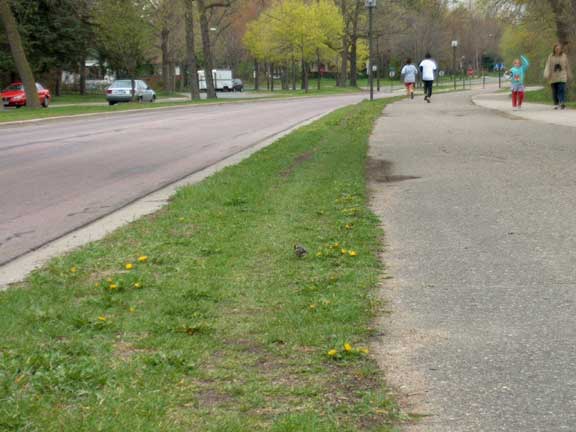
Above: Male
bay-breasted warbler foraging for insects along the West River Road,
roughly 1.5 miles south of Augsburg College in Minneapolis.
Below: Closer
view of same bird
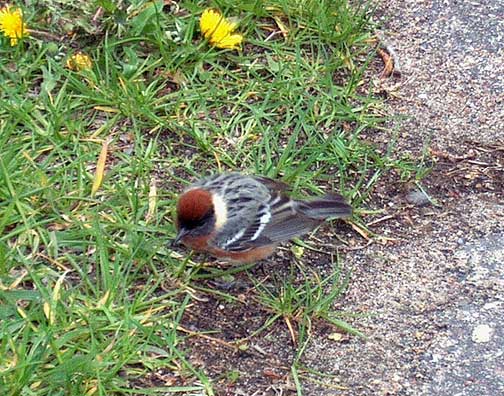
Bay breasted
warblers are not common in this area, being seen only when migrating
through to or from their breeding grounds to the north. Due to its apparent
lack of concern about our presence, this bird attracted considerable
attention from several sets of birdwatchers. We sat in the grass and
watched and photographed this bird for about 15 minutes, during which
time it came within a few feet of us on multiple occasions. Then, a
bicycle came past and startled the bird, causing it to fly out in front
of a passing car. Impact with the car killed the bird instantly.
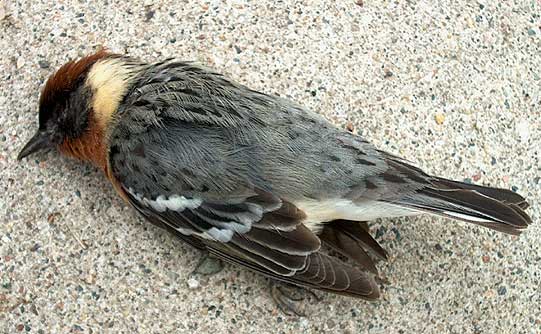
Above: male
bay breasted warbler moments after being killed by a car.
After observing
this bird for so long, seeing it killed abruptly was disturbing and
disappointing. More importantly though, this event illustrates several
more important points. Namely, migration is a difficult time for birds,
and human activities can have a big impact on wild populations.
Many of our
North American birds migrate. If asked why birds migrate, most people
would probably say that they migrate south in the Fall to avoid the
cold of northern winters, but that is mostly incorrect. The main reason
for these migrations is due to food shortages during northern winters.
Bird species that can find food all winter in the North tend to stay
in the North all year round. Many species of seed eaters stay all year
round, as do birds such as some of the woodpeckers that forage for dormant
insects in tree bark. Even very small birds such as chickadees can survive
harsh northern winters, despite their small size (which gives them a
large surface area to volume ratio, meaning that they will tend to lose
body heat extremely rapidly). The 50 or so species of warblers that
nest in North America, on the other hand, are specialists at gleaning
insects from vegetation, constantly flitting from twig to twig or branch
to branch in their search for insects, and occasionally even grabbing
an insect or two out of the air. The sorts of insects warblers eat are
not available in the winter in the North, so they fly south in the Fall
to spend the winter in more suitable habitats in the southern states,
the islands of the Caribbean, Central America, and even South America.
Birds such as swallows, swifts, and nighthawks are specialists at capturing
flying insects out of the air, and hummingbirds feed on flower nectar
and insects captured from flowers. These birds, along with many other
species, migrate as well. Often migrating birds travel enormous distances,
even crossing large bodies of water such as the Gulf of Mexico without
stopping until they reach the distant shore - even tiny ruby-throated
hummingbirds cross the Gulf of Mexico. There are some species of songbirds
and shorebirds that even travel from Canada or Alaska to south Pacific
Islands! It is important to remember that these birds are not seabirds....the
ocean is an inhospitable place for these birds so they cannot stop to
feed or rest until they reach land (in contrast, migrating arctic terns,
which migrate from the arctic to the Antarctic and back every year are
seabirds that have the potential of feeding along the way).
Such migrations
are absolutely phenomenal feats, but they are undertaken because these
migrations allow the birds to utilize the rich food resources (e.g.
abundant insects) of the North during the breeding season even though
these areas are not habitable for these particular bird species in the
winter. These migrations are costly, however. Long migrations require
phenomenal amounts of energy, which can leave the birds in an emaciated
state. Not all individuals survive the rigors of migration, and those
that do need to feed fast and furiously when they get the chance to
regain lost body weight. In the Fall, there is a certain urgency because
conditions are deteriorating in the North, so the birds cannot linger
too late into the season. On the return trip to their breeding grounds
in the Spring there is another sort of urgency, for there can be intense
competition for breeding territories in the North... a bird that arrives
too late might have difficulty establishing a breeding territory. Thus,
these birds cannot dally any longer than necessary, but the danger of
pushing North too soon is possible starvation should there be a late
Spring cold snap. And if they live long enough, and some do, the birds
have to face these problems year after year for a number of years.
And you thought
YOUR life is difficult sometimes!
In the case
of the bay-breasted warbler whose life was cut short by a car, this
individual had possibly already made several round trips. This species
nests throughout much of Canada and in a few slivers of the United States
near the Canadian border, but spends its winters in northern South America,
so it travels a significant amount each year. My guess is that the bird
in these photos and many of the other warblers we saw that evening,
were distracted by great hunger, resulting in riskier feeding behavior
than they might normally exhibit. Furthermore, given that they were
not local residents, they were less familiar with their surroundings
than resident birds would be, and they were feeding in habitats that
might not be their normal habitats (bay-breasted warblers normally nest
in coniferous forests, for example).
Cars of course
kill a lot of wildlife, not just migrating songbirds, but there were
other hazards that evening for the migrating warblers. On our short
walk we saw an inordinate amount of hunting behavior on the part of
the local cats. Within a three block stretch within the local residential
area, we observed two different cats stalking and nearly catching yellow-rumped
warblers, and earlier in the day we observed a neighbor's cat carrying
a dead warbler in its mouth. Thus, not only do we humans reduce wildlife
populations with our cars, but high predation from pet cats allowed
to run free also reduces native bird populations.
Many birds,
both migrants and otherwise, also die due to collisions with various
man-made structures. Not the least of these hazards are large windows
that birds attempt to fly right through, not noticing that there is
glass blocking their path. To reduce such impacts images of hawks or
falcons or models of owls are sometimes hung in or near large windows
to scare off smaller flying birds. The photo below shows the profile
of a falcon placed in the large windows of the Lake Harriet bandshell
in Minneapolis.
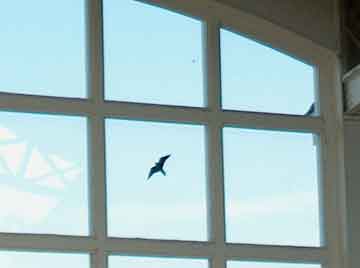
Though the above
factors do indeed kill many birds, the effects of cars, cats, and man-made
structures are probably small compared to a much more insidious effect
of human activity....habitat destruction. Populations
of many North American songbirds (and other wildlife) are declining,
in part due to loss of breeding habitat in the United States, but also
due to alteration of habitats in the bird's tropical overwintering grounds
due to human activities such as farming and deforestation. Indeed, habitat
destruction is the most significant cause of the major declines in many
animal and plant species that are occuring worldwide.
Fragmentation
of forests into small patches also exposes forest dwelling birds to
increased levels of nest parasitism by brown-headed cowbirds, which
are birds of open country and forest edges. Cowbirds lay their eggs
in the nests of other songbirds (removing a host species egg from the
nest each time they lay an egg), who are tricked into raising the cowbird
young. Often the young cowbirds are larger than the young of their adoptive
parents, and the cowbird young compete for food and space and sometimes
kick their nestmates out of the nest prematurely. This all can reduce
the reproductive success by the host species.
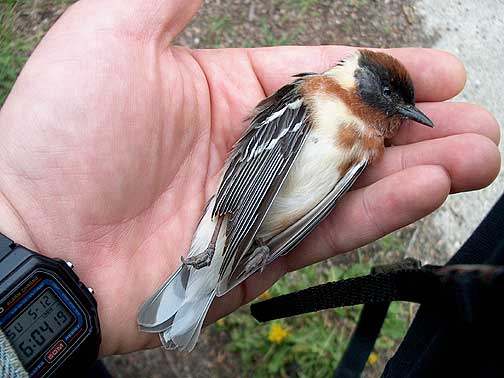
Links:
For more information
on cowbirds and the controvesy over their effects on songbirds, go to
the following web sites:
http://audubon.org/bird/research/#introduction
http://cowbird.lscf.ucsb.edu/
http://www.suttoncenter.org/bhco.html
http://www.prbo.org/Cowbirdlinks.html
For information
on a very interesting book on bird migration, go to:
http://www.fsbassociates.com/fsg/livingwind.htm

